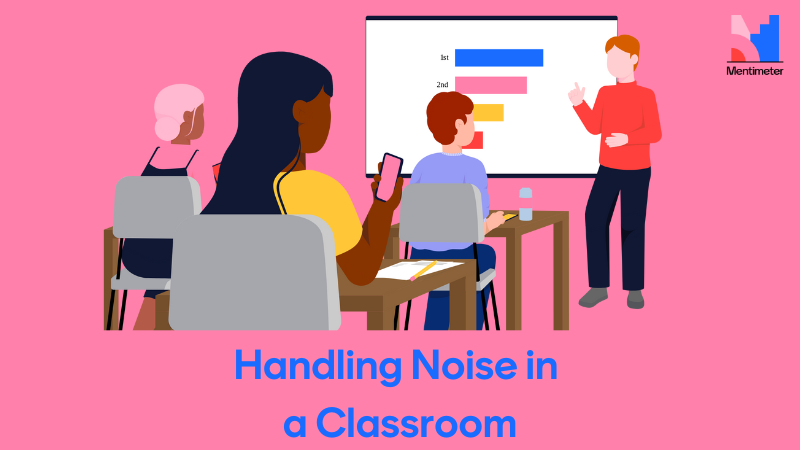Now and then your classroom may inevitably get noisy. Often it is like a domino effect, one starts talking, and then like a wave, it takes over the entire classroom. The best technique to handle noise is to prevent it from getting noisy in the first place. Easier said than done right?
A crucial tip is not to shout even if they get loud, reacting to noise with noise rarely makes anything better. The earlier you set a standard the less your students will question it. This article will give you tips on how to handle a noisy classroom and how to make even the noisiest of students listen.
No matter their age, no matter what subject they may be teaching, there are those days when the decibels in the classroom seem to keep climbing and climbing. Sometimes students may just be full of energy, other times they are more intent on discussing anything but schoolwork. No matter the situation it can be disruptive to your lesson plans to have countless voices vying to be heard at the same time.
As much as you want to try to match your student's volume is not the way to go if you want them to both calm down and quiet down. So we have looked at some techniques and tips any faculty member and teacher can implement the next time they feel the noise level of the class is becoming disruptive.
See how Mentimeter can improve the classroom experience
Learn moreThe problem of classroom disruptions
The National Center for Education Statistics has highlighted the severity of classroom disruptions, identifying them as a common and serious issue. Disruptive behavior can negatively impact student learning and safety by creating distractions and an unsafe environment.
To combat these issues, educators can use proactive and positive classroom management strategies, set clear expectations, and consistently enforce them. The report suggests that "teachers can reduce disruptive behavior by setting clear expectations, positively reinforcing good behavior, and maintaining consistent routines, thereby fostering a positive classroom environment."
How to reduce classroom noise
- Set the tone early
- Address students individually
- Only say things once
- Make activities more engaging
- Promote active listening
- Listen more
Set the tone early
It's crucial to ensure that students know how to act when entering the classroom, even after a break or lunchtime. Establishing clear expectations for classroom behavior and outlining the lesson plan can help students stay calm and focused during lessons.
Taking a few minutes to remind the class how to enter the classroom and behave during the lesson sets the tone for a structured and productive environment. Providing clear instructions for activities and encouraging quiet, respectful behavior can further promote a positive classroom atmosphere.
Address students individually and not as a group
To effectively manage a noisy classroom, it's best to focus on individual students rather than addressing the entire group. This approach eliminates the "power in numbers" effect that may encourage students to continue disruptive behavior. By personally identifying the noisiest students and emphasizing consequences for their behavior, they are more likely to respond and quiet down.
Once these main culprits are silent, the rest of the class should follow suit. Additionally, using praise and incentives for well-behaved students promotes a positive classroom environment, rather than unjustly punishing the entire class for the actions of a few.
Say things once only
Effective behavior management and student conduct in the classroom require encouraging attentive listening to instructions the first time they are given. Repeating instructions can lead to lazy listening habits and prevent students from taking responsibility for their own learning. By establishing a clear standard early on and informing your students that instructions will not be repeated, they will understand that attentiveness is their responsibility.
This approach promotes a culture of engagement and fosters the expectation that students must be alert and focused during crucial moments. Implementing effective behavior management and encouraging positive student conduct through attentive listening can enhance the learning experience for everyone involved.
Make activities more engaging
Effective classroom management is essential to maintain a suitable sound level and minimize classroom disruptions caused by students talking to each other. Instead, try to engage students from the start by using a variety of interactive activities such as games, quizzes, and exercises that encourage creativity, brainstorming, and problem-solving.
There are plenty of tools and software available to make lessons more interactive, so finding engaging ways to teach should be easier than ever before.
Encourage active listening
Teaching listening skills to students is crucial for effective classroom management. Practicing listening through games such as Simon Says or Popcorn Storytelling can improve students' ability to manage classroom noise and filter out background noise.
This skill not only benefits their academic life but also enhances their communication, empathy, and relationship skills.
Listen More
Modeling good listening behavior is essential to promoting effective communication and building strong teacher-student relationships in the classroom. One effective technique is call and response, where students repeat and respond to what the teacher says. Positive body language and taking the time to get to know students on a personal level can also support and demonstrate good listening skills.

Get to know your students
A quieter, more considerate classroom for everyone
Hopefully, these tips and suggestions can help you better control the volume levels of your classroom and maintain both productivity and engagement levels. When it comes to providing students with interactive learning material, we here at Mentimeter have a series of resources you can access with little to no effort. From templates to webinars for educators, we can help take your next lesson to a whole new level.
Explore everything that Mentimeter can do to help make the classroom a more engaging and interactive place!
Learn about Mentimeter Education



